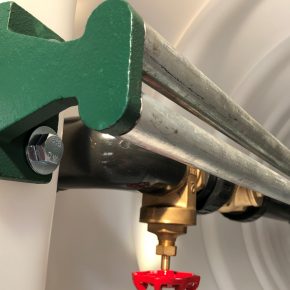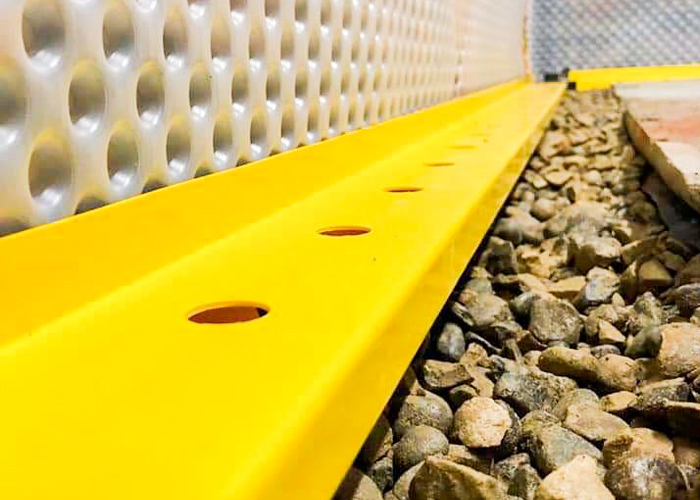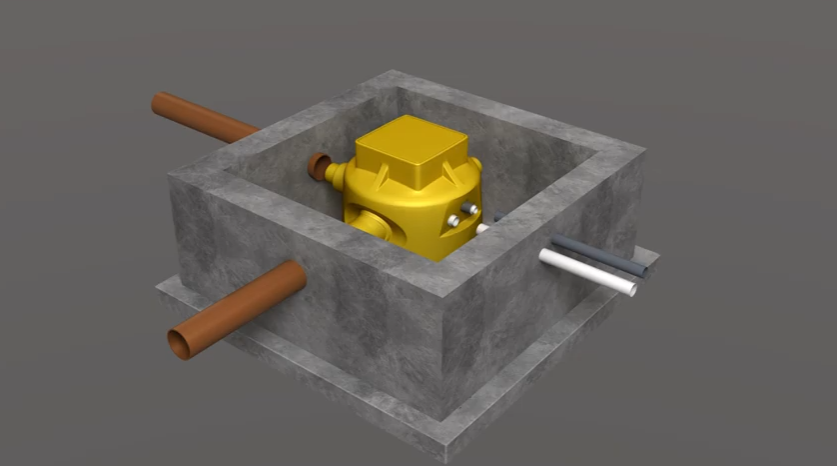
The Lowdown on Basement Drainage with Delta Membranes
When waterproofing a below ground structure with a Type C cavity membrane system, a suitable basement drainage system is also required to safely remove ground water ingress which percolates the structure, explains Delta Membranes…
This drainage system is made up of four key components – a submersible pump (often referred to as a sump pump), basement drainage channels/modular drainage system, high level water alarm(s), and battery backup(s). Larger projects may also require a control panel.
The first stage of a cavity drainage system install is to provide an accessible and maintainable drainage system. Whether new build or retrofitting, the drainage system is always the first step.
Drainage can be the use of perimeter drainage channel or a modular drainage system or a combination of both which are used in conjunction with wall and floor membranes ensure any water ingress will flow to a suitable outlet or discharge point.

Modular drainage systems are only possible where the construction is new or there is a new structural slab being cast.
Perimeter drainage channel can be used for new construction and retrofitting projects. Recesses for the perimeter drainage channel are created in the structural slab.
Contrary to new build scenarios, when retrofitting there may be limitations to alterations to the existing slab. To overcome this problem a 50mm sacrificial screed can be used to create the required rebates.
Delta’s different approach
With multi-level basements, Delta takes a slightly different approach. Generally, with a new build multi-level basement, the company ties the intermediate slab into the membrane for continuity of the waterproofing system, [Technical drawing 218-1(C)]. But as with all waterproofing projects, this is not always possible. Where not possible, Delta use an alternative approach, such as the 216 Detail [Technical drawing 216-1-(c)].
Both perimeter drainage channels and modular drainage will efficiently disperse water ingress which percolates the structure to a sump chamber.

The sump chamber will collect and manage any water ingress which is collected in the cavity drainage system and then safely evacuate this to a suitable discharge point. This is referred to as a sump pump system. A sump pump system protects a property against flooding.
Once the basement drainage has been constructed, the next construction phase should be site preparation, then the Type C membrane installation.
‘Holy grail’
Integrity testing is the ‘holy grail’ and should always be undertaken prior to any finishes. In all cases, flood testing of the waterproofing system is the recommendation. The practice of flood testing Type C installations with a significant amount of water flow is a critical step to ensuring there are no defects to workmanship and that the waterproofing system is capable of controlling water ingress as designed.
High level water alarms, control panels and battery backups are a second line of defence for the basement drainage system. A high-level water alarm will notify the building occupants if the sump pump system has stopped working or are working at different parameters. Battery backups will maintain a power supply to the sump pumps in the event of a power outage.
As with any electrical equipment, basement sump pumps will require servicing. As well as this, the entire drainage system will require regular maintenance to ensure it is working effectively. Think of sump pumps as the beating heart of your basement, removing water ingress that could cause a flooded basement.
Delta has been manufacturing waterproofing products for over 125 years, with the aim of always providing the best customer experience.
It has a trusted, proven and dedicated support network. Call Delta and you’ll get straight through to one of its highly qualified and helpful Technical Waterproofing Consultants.
Delta Membrane Systems,
Delta House,
Merlin Way,
North Weald,
Epping,
Essex,
CM16 6HR
United Kingdom
Visit Delta Membrane Systems' website
Visit Supplier's page
Latest news

28th March 2025
Ideal Heating Commercial announces 10-year warranty on Evomax 2 boiler
Evomax 2, the UK’s number one selling commercial wall-mounted boiler from Ideal Heating Commercial, is now available with a 10-year warranty.
Posted in Articles, Building Industry News, Building Products & Structures, Building Regulations & Accreditations, Building Services, Facility Management & Building Services, Heating Systems, Controls and Management, Heating, Ventilation and Air Conditioning - HVAC, Innovations & New Products, Pipes, Pipes & Fittings, Plumbing, Retrofit & Renovation, Sustainability & Energy Efficiency, Videos
28th March 2025
FLIR Si1-LD Acoustic Imaging Camera for Compressed Air Leak Detection
FLIR, a Teledyne Technologies company, introduces the Si1-LD, an industrial acoustic imaging camera that brings faster and more accurate compressed air leak detection to those operating on a modest condition monitoring budget.
Posted in Acoustics, Noise & Vibration Control, Articles, Building Industry News, Building Products & Structures, Building Services, Facility Management & Building Services, Information Technology, Innovations & New Products, Retrofit & Renovation, Sustainability & Energy Efficiency, Thermal Imaging and Monitors
28th March 2025
LIFTEX 2025 Seminar programme announced
Registration has opened for LIFTEX 2025. Now in its 37th year, LIFTEX 2025 is the UK’s only dedicated exhibition for the lift, escalator and access industry and takes place only once every three years.
Posted in Access Control & Door Entry Systems, Accessibility, Articles, Building Industry Events, Building Industry News, Building Products & Structures, Building Regulations & Accreditations, Building Services, Exhibitions and Conferences, Facility Management & Building Services, Health & Safety, Retrofit & Renovation, Security and Fire Protection, Seminars
28th March 2025
MCRMA welcomes ArcelorMittal UK to membership
A UK division of the global steelmaking business ArcelorMittal has become the latest new member of the MCRMA, the industry association representing the metal building envelope sector.
Posted in Articles, Building Associations & Institutes, Building Industry News, Building Products & Structures, Building Systems, Cladding, Facades, Posts, Restoration & Refurbishment, Retrofit & Renovation, Roofs, Steel and Structural Frames, Walls
 Sign up:
Sign up: